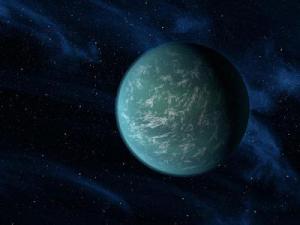On science blogs this week: Astrobiology
SEARCHING FOR LIFE-AS-WE-KNOW-IT. NASA's announcement of discovery of the "Earth-like" exoplanet Kepler-22b sent astrobiologist Adam Frank over the moon — 600 light years over, in fact. At 13.7 Cosmos and Culture he rhapsodized:
Something has changed for us. Something new and remarkable has happened. We have entered the age of planets and, even if you can't see it now, nothing will ever be the same.
Yes, it was a cool event. But perhaps not quite that cool. At Bad Astronomy, for example, Phil Plait explains that Kepler-22b is not the first exoplanet to be discovered in the so-called habitable zone around a distant Sun-like star, although it is the first discovered by the space-based Kepler observatory and the first that is not a gas giant. Observe his carefully worded evaluation:
But is the planet like our own world? That’s hard to say.
Reporting has left the impression that this exoplanet is Earth's twin orbiting a Sun-like star. But whether you accept that declaration surely depends on the, uh, flexibility of your definition of Earth-like and Sun-like.
Let's just say it's the closest find yet. But to call Kepler-22b Earth's twin is stretching the meaning of "twin." There are some pretty big differences. One is literally big: Kepler-22b's radius is nearly 2.5 times larger than Earth's. And no one knows whether it's a largely rocky planet like Earth; it could be mostly gas or liquid. At Cosmic Log, Alan Boyle explains why some experts think 22b might be a lifeless gassy planet, although he holds out hope that a moon might be livable, as in Avatar.The planet's star, Kepler-22, is cooler than the Sun and has a lower mass. But the planet itself probably has significantly more mass than the Earth. At Life Unbounded, astrobiologist Caleb Scharf explains the difficulties of determining planetary mass at this distance and why at this point an estimate of mass is only a guess.
The reason these big differences have gotten obscured is that the exoplanet's year is 290 days. So it orbits its cooler sun at the right distance for water to exist in liquid form, and water in liquid form is a precondition for life-as-we-know-it. If, of course, water in any form exists there. Which no one knows either. Plait points out that Mars and Venus are technically within the Sun's habitable zone too.
Find a video of the announcement here. Find a link to the arXiv paper on Kepler-22b here.
Expect more of these hypothetically Earth-like things. NASA says Kepler has so far found ten other candidate objects that are sorta Earth-sized and exist in the right zones for liquid water. But it remains to be seen if they are actual planets, let alone suitable for life-as-we-know-it.
If you survive long enough, you will probably be deluged with Earth twin discoveries. Plait estimated last year that there might be 2.5 billion planets that are potentially habitable — and that's just in our own galaxy. You're not likely to get a chance to inspect any of them in person, though. Kepler-22b, for instance, is 600 light years distant.
The next step, says astrobiologist Scharf, is to "get our hands on spectroscopic measurements of Earth-sized and super-Earth sized worlds." And to do that, he asserts, we need the James Webb Space Telescope, which is designed to study the birth and evolution of galaxies and the formation of stars and planets. Irritated at cost overruns, Congress nearly killed the telescope over the summer, but then rescued it from that near-death experience last month.
A big question to me, but one hardly ever mentioned, is whether it makes sense to focus the search for ET wholly on life-as-we-know-it. I suppose we have to start some place, and seeking organisms that need water is not crazy. But doesn't it also make sense to think a bit about searching for life-as-we-don't-know-it? If there's one thing that the study of life, the universe, and everything should have taught us by now, it's that we should expect to find the unexpected.
PARDON ALAN TURING, 60 YEARS TOO LATE. At ScienceBase, David Bradley explains why you should sign the petition urging the British government to pardon Alan Turing. Its homophobic treatment of a man who should be a national hero, a world hero even, was appalling, even if not untypical of the times. Alas, you are only allowed to sign the petition if you're a Brit or live in the UK. David notes:
Turing invented the concept of the modern computer, devised the first real test for artificial intelligence and cracked the German codes to help bring WWII to an end. Turing also figured out how the leopard got its spots and what makes zebras stripy.
OPEN LAB WINNERS. Open Lab is an annual competition that results in a compilation of fine science blogging. The 2012 winners have just been announced; find the list here.
BLOGGERS ARE NOT (NECESSARILY) JOURNALISTS. Not much blogging yet about that Federal judge's finding that a Montana blogger sued for defamation was not a journalist and so not entitled to legal protections enjoyed by recognized news sources. Here's the AP story about the case
Hank Campbell fulminated at Science 2.0, partly by lifting sections of the AP story verbatim (and, of course, without attribution.) He's mad as hell, but makes no coherent case that bloggers as a class should be entitled to First Amendment protections.
According to the AP piece, the blogger in question offered an exceedingly odd defense:
Cox said she considered herself a journalist, producing more than 400 blogs over the past five years, with a proprietary technique to get her postings on the top of search engines where they get the most notice. "What could be more mainstream than the Internet and the top of the search engine?" she said.
BIG NEWS ABOUT THE HIGGS BOSON ON TUESDAY NEXT. Or maybe not. Quantum Diaries Survivor Tommaso Dorigo explains.




